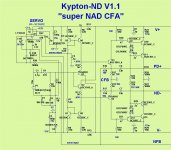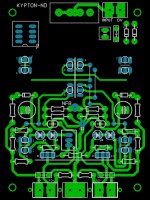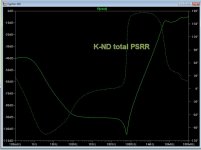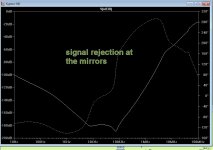Yes. Changing the current of the CCS modify the operating point of the input transistor, thence, the voltage on their collector. The benefit is that it is an other feedback path. I don't know witch is better, distortion side.
I've simulated different way to connect a DC servo, via input CCS too, and came to conclusion that it needs more voltage swing at the DC servo opamp output to correct the DC offset than if connected conventionally, to the feedback input. And that means more prone to saturation of the opamp. It can look that in that case the opamp is not inside the signal path, but it is not so.
No way. If it can change the output voltage, it is IN the signal path, one way or an other.Which way best removes the servo from the audio path?
The advantages and inconveniences of DC servos has been discussed in details in last pages of the Blowtorch thread.So maybe servo is not the best?
I put up what Bob Cordell said on that thread a couple days ago. He was talking about using two op-amps with one of them being inverting and getting rid of the coupling caps I think.
I have decided on the Spooky. I have tried to assemble a BOM but I would like to know what the MKP capacitotrs are laid out for in millimeters or tenth of inch? Will ERO Roederstein MKP 250v caps fit? I assume the small value electrolytic are OSCON solid aluminum? Ray
The servo of OS modify the current balance between the two CSS instead of injecting a voltage in the feedback path.
Changed that again ! 😀
Went back to the current mirrors (like the kypton C) - (below 1).
4 Red led cascode is also added.
(below 2) - I'm almost done with the layout ,as well. 😱
The mirrors give even better PSRR than the LED CCS's and DO NOT
saturate the servo (below 3).
With the mirrors , just the resistors (which have no co-efficient)set the current.
This just leaves Q1-4 thermally , but they fully cancel as does the
Baxandall cascode VAS. We just about have 0 !
I added C5 to the mirrors servo node to give me very good signal
rejection at that node (NO audio is getting through - below 4).
Overall , the IPS is <10ppm 20hz-20Khz , with >90db PSRR. UG is
1.6mhz @ a healthy 300v/us slew. Meets my criteria 😀 .
PS - no more blinding Blue led's !!
OS
Attachments
I have decided on the Spooky. I have tried to assemble a BOM but I would like to know what the MKP capacitotrs are laid out for in millimeters or tenth of inch? Will ERO Roederstein MKP 250v caps fit? I assume the small value electrolytic are OSCON solid aluminum? Ray
poly caps are mostly 5mm , if you use my artwork some caps are multi-pitch.
Most electrolytic's are multi-pitch (5/7.5 or 3.5/5mm).
Electrolytic's are usually Nichicon VP , PM , PV - mouser standard stock.
OS
Which way best removes the servo from the audio path?
Even a passive trimmer offset adjust will allow rail ripple and other garbage
into the audio path. Actually more than the servo because an op-amp
has it's added PSSR at it's output (a cleaner reference voltage).
But that "cleaner reference" is also actively adjusted (superior).
As passives age on an amp , offset will increase with time - not
so with a servo. 30 year old (servo'ed) Japanese amps have 1-2mv offset
.... and still WORK !!
OS
I put up what Bob Cordell said on that thread a couple days ago. He was talking about using two op-amps with one of them being inverting and getting rid of the coupling caps I think.
Although, I agree with Bob, there's a way to arrange a non-inverting servo with just one cap (and one OpAmp). See schematic >HERE<
Also, I did a lot of tests and live measurements - a good (well designed) servo does not influence the sound neither objectively, nor subjectively. Even being connected right to the input - like >HERE<
So... don't be afraid of servos 😉
Cheers,
Valery
P.S. Not all the (yogurts) OpAmps are equally "healthy". I use LF411 (AD711) in most cases. Good one. Key parameters to look at - fets at the input (high input impedance), low offset, low noise.
Last edited:
Yes , pick on my TL072's 😛Although, I agree with Bob, there's a way to arrange a non-inverting servo with just one cap (and one OpAmp). See schematic >HERE<
Also, I did a lot of tests and live measurements - a good (well designed) servo does not influence the sound neither objectively, nor subjectively. Even being connected right to the input - like >HERE<
So... don't be afraid of servos 😉
Cheers,
Valery
P.S. Not all the (yogurts) OpAmps are equally "healthy". I use LF411 (AD711) in most cases. Good one. Key parameters to look at - fets at the input (high input impedance), low offset, low noise.
I see you are biasing the input with a filtered non-inverting servo . Did this
one my first "NAD".
My non-inverting servo (on the ND) is inverted by the mirrors. So it
ends up as a inverting servo in the end. Any slight servo error (HF) is
additionally cancelled by NFB.
You may of offset this by using a higher quality op-amp. this is how
the OEM's get away with using junk op-amps like a ne5532 , servo'ing
a NFB node will compensate for an inferior servo.
Thinking about it , my ND has a DC VFA inverting input , a VFA non-inverting
input (the diamond input) and a CFA inverting input - a big 3 input
op-amp.
OS
Last edited:
The advantages and inconveniences of DC servos has been discussed in details in last pages of the Blowtorch thread.
Which leads me to ask...
...is it an inconvenient truth?
build question
I've seen a board here and it looks as though
two pair of IC are mirrored. If I read it correctly
the are mounted facing each other, touching
and then what looks like copper pipe is
then crimped over them?
It looked like hard copper, also had a wire tie around it.
couldn't see what the wire tie function was.
Looked like the copper might be used for shielding,
if stood off from the board, then would also serve
as derating and a stack...hopefully not a smoke stack.
What size do you recommend? What length? How to stand off, etc?
I've seen a board here and it looks as though
two pair of IC are mirrored. If I read it correctly
the are mounted facing each other, touching
and then what looks like copper pipe is
then crimped over them?
It looked like hard copper, also had a wire tie around it.
couldn't see what the wire tie function was.
Looked like the copper might be used for shielding,
if stood off from the board, then would also serve
as derating and a stack...hopefully not a smoke stack.
What size do you recommend? What length? How to stand off, etc?
Terry,
I think you are right that was Thimios whoe did the copper tube trick. What I wondered about that was if the tube actually increased the time for the settling time of those devices as it is acting as a sink and I would think the entire copper tube would have to normalize to the temp of the transistors. Not sure the answer is to that.
I think you are right that was Thimios whoe did the copper tube trick. What I wondered about that was if the tube actually increased the time for the settling time of those devices as it is acting as a sink and I would think the entire copper tube would have to normalize to the temp of the transistors. Not sure the answer is to that.
I just use thermal paste and heatshrink tubing. Seems to work well enough though I don't doubt anything that thimios does. He is a mentor.
OS, I'm not being picky here, or maybe I am, I just want to understand for
clarification sake.
Please understand, I'm trying to learn for the first time, what most of
y'all have forgot.
A passive trimmer offset adjust lets more shirt, ripple, and unwanted trash
into the music than a servo would (inferior).
Most amps should work with 1 - 2 mV offset shouldn't they?
Not just Japanese amps?
I have 60 to 70 year old American amps that work just fine.
Nope let's say 50 years old, but they are tube amps.
Anyway, you're saying the 30 old Japanese stuff still works
fine because they have the servo, which compensates
for the age and drift of passives.
Instead of having something that sounds like dodo or has
had so much offset they melted down, fried and died,
the servo amps take a licking and keep on ticking.
Holy Smokes OS, how do you design this stuff so quickly?
Are you taking one thing you know really well then doing
different iterations?
OR actually probably a combination, which follows:
Some of the above, but have most of the other circuits
optimized to the point where changes won't be significant.
AND
Focus on the part that WILL have the most impact,
the most variability....
Heck, with everything else held constant...which is what we need to do...
we can finally see what the different topologies actually offer...
we can have our cake and eat it too,
we can have our pie and eat it,
our beer, our wine, our whatever...
Which reminds me of what an old Italian guy (who used to own
The Mediterranean Market) explained to my pop
and my pop handed this down to me, which I'll share with y'all...
He Said, "Corv, (my pops nick name) drinking wine isn't about what you
read, or the medals they've won or didn't win, or the price high or low,
or what someone else thinks or says...even your buddies, your wife
or girlfriend, it's not about it rating or anything else...forget everything else
because none of that matters...what really matters is what it means to you
and whether you liked it, that's it.
You can go to a tasting and try this or that and have a horrible experience.
Or, you can be with someone special and you just run in someplace and
buy a cheap bottle of wine and with that person you just have a
wonderful time which you'll remember fondly for all life, and that wine
will always have a special taste, a special place always just for you."
So too is this place, DIY Audio, which is why I enjoy it so much and you
gents do such a good thing here. It's all about trying and tasting these things
and just finding what works for us. We are all different have differences
in hearing sensing etc yet are Gung Ho getting these things to make some
fricking Music.
Now I'm going to crank up my stereo, tune my axe, grab an amp
plug in and play some Jazz, Rock, then blues.
I'm not very good, but I have a damn good time. : )
)
clarification sake.
Please understand, I'm trying to learn for the first time, what most of
y'all have forgot.
The servo has the cleaner reference because it is actively adjusted (superior).Even a passive trimmer offset adjust will allow rail ripple and other garbage into the audio path. Actually more than the servo because an op-amp has it's added PSSR at it's output (a cleaner reference voltage). But that "cleaner reference" is also actively adjusted (superior).
A passive trimmer offset adjust lets more shirt, ripple, and unwanted trash
into the music than a servo would (inferior).
As passives age on an amp , offset will increase with time - not
so with a servo. 30 year old (servo'ed) Japanese amps have 1-2mv offset
.... and still WORK !!
Most amps should work with 1 - 2 mV offset shouldn't they?
Not just Japanese amps?
I have 60 to 70 year old American amps that work just fine.
Nope let's say 50 years old, but they are tube amps.
Anyway, you're saying the 30 old Japanese stuff still works
fine because they have the servo, which compensates
for the age and drift of passives.
Instead of having something that sounds like dodo or has
had so much offset they melted down, fried and died,
the servo amps take a licking and keep on ticking.
Holy Smokes OS, how do you design this stuff so quickly?
Are you taking one thing you know really well then doing
different iterations?
OR actually probably a combination, which follows:
Some of the above, but have most of the other circuits
optimized to the point where changes won't be significant.
AND
Focus on the part that WILL have the most impact,
the most variability....
Heck, with everything else held constant...which is what we need to do...
we can finally see what the different topologies actually offer...
we can have our cake and eat it too,
we can have our pie and eat it,
our beer, our wine, our whatever...
Which reminds me of what an old Italian guy (who used to own
The Mediterranean Market) explained to my pop
and my pop handed this down to me, which I'll share with y'all...
He Said, "Corv, (my pops nick name) drinking wine isn't about what you
read, or the medals they've won or didn't win, or the price high or low,
or what someone else thinks or says...even your buddies, your wife
or girlfriend, it's not about it rating or anything else...forget everything else
because none of that matters...what really matters is what it means to you
and whether you liked it, that's it.
You can go to a tasting and try this or that and have a horrible experience.
Or, you can be with someone special and you just run in someplace and
buy a cheap bottle of wine and with that person you just have a
wonderful time which you'll remember fondly for all life, and that wine
will always have a special taste, a special place always just for you."
So too is this place, DIY Audio, which is why I enjoy it so much and you
gents do such a good thing here. It's all about trying and tasting these things
and just finding what works for us. We are all different have differences
in hearing sensing etc yet are Gung Ho getting these things to make some
fricking Music.
Now I'm going to crank up my stereo, tune my axe, grab an amp
plug in and play some Jazz, Rock, then blues.
I'm not very good, but I have a damn good time. :
 )
)
Last edited:
- Home
- Amplifiers
- Solid State
- Slewmaster - CFA vs. VFA "Rumble"



